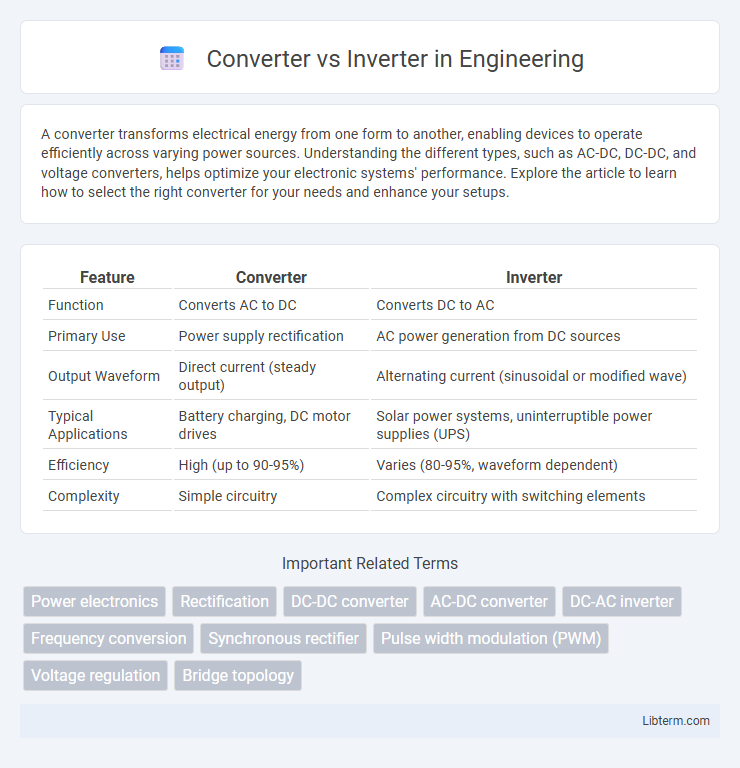A converter transforms electrical energy from one form to another, enabling devices to operate efficiently across varying power sources. Understanding the different types, such as AC-DC, DC-DC, and voltage converters, helps optimize your electronic systems' performance. Explore the article to learn how to select the right converter for your needs and enhance your setups.
Table of Comparison
| Feature | Converter | Inverter |
|---|---|---|
| Function | Converts AC to DC | Converts DC to AC |
| Primary Use | Power supply rectification | AC power generation from DC sources |
| Output Waveform | Direct current (steady output) | Alternating current (sinusoidal or modified wave) |
| Typical Applications | Battery charging, DC motor drives | Solar power systems, uninterruptible power supplies (UPS) |
| Efficiency | High (up to 90-95%) | Varies (80-95%, waveform dependent) |
| Complexity | Simple circuitry | Complex circuitry with switching elements |
Introduction to Converter vs Inverter
Converters transform electrical energy from one form to another, such as converting AC to DC or changing voltage levels, making them essential in power supply systems. Inverters specifically convert DC power back into AC power, enabling devices like solar panels and battery systems to supply household appliances. Understanding the fundamental roles and applications of converters and inverters is crucial for optimizing energy systems and ensuring efficient power management.
What is a Converter?
A converter is an electronic device that changes electrical energy from one form to another, typically altering voltage, current, or frequency to suit specific applications. It primarily converts alternating current (AC) to direct current (DC) or DC to DC at different voltage levels, enabling compatibility between power sources and devices. Converters are essential in power supplies, battery charging, and various industrial systems for efficient energy management.
What is an Inverter?
An inverter is an electronic device that converts direct current (DC) into alternating current (AC), enabling the use of electrical devices that require AC power from DC sources such as batteries or solar panels. Unlike converters that primarily change voltage levels, inverters provide a stable AC output with specific frequency and waveform suitable for household appliances and industrial equipment. Modern inverters often include advanced features like sine wave output, power conditioning, and energy efficiency optimization.
Key Differences Between Converter and Inverter
Converters change alternating current (AC) to direct current (DC) by rectifying the input voltage, while inverters convert DC back to AC, enabling the use of stored electrical energy in batteries. Key differences include their primary function: converters provide stable DC power for electronic devices, whereas inverters generate AC power for household appliances and grid supply. Efficiency, waveform output, and application scenarios also distinguish converters, which typically produce a steady DC output, from inverters that often create variable-frequency AC suitable for various load types.
Types of Converters
Converters are categorized into several types, including AC to DC converters (rectifiers), DC to AC converters (inverters), DC to DC converters (choppers), and AC to AC converters (cycloconverters). Each type plays a distinct role in power electronics by performing specific voltage and current transformations to improve efficiency and compatibility in electrical systems. Understanding these types enables better selection of power conversion devices for applications in renewable energy, electric vehicles, and industrial automation.
Types of Inverters
Inverters are classified into three main types: square wave, modified sine wave, and pure sine wave inverters, each varying in output waveform and efficiency. Pure sine wave inverters provide the highest quality power, closely matching utility power, ideal for sensitive electronics and high-performance appliances. Modified sine wave inverters balance cost and performance, while square wave inverters are simple and inexpensive but suitable only for basic, non-sensitive devices.
Applications of Converters
Converters are widely used in industrial motor drives, power supplies, and battery charging systems, where they efficiently change AC to DC or DC to DC to meet specific voltage and current requirements. In renewable energy systems, converters enable solar panels and wind turbines to deliver stable and usable power by adjusting voltage and current levels. Precision in voltage regulation and energy conversion makes converters essential in electric vehicles and uninterruptible power supplies (UPS) for continuous and reliable operation.
Applications of Inverters
Inverters are widely used in renewable energy systems such as solar and wind power to convert DC electricity into AC for grid compatibility and household use. They play a crucial role in uninterruptible power supplies (UPS) and electric vehicles, ensuring stable and efficient power delivery. Industrial automation and variable frequency drives also rely on inverters for precise motor control and energy efficiency.
Pros and Cons: Converter vs Inverter
Converters efficiently change AC to DC and are ideal for devices requiring stable direct current but can cause energy loss due to heat generation. Inverters transform DC to AC, enabling the use of renewable energy sources and offering flexible power output, though they often have higher initial costs and complexity. Choosing between converter and inverter depends on the specific power needs, efficiency requirements, and device compatibility.
Choosing the Right Solution: Converter or Inverter
Choosing between a converter and an inverter depends on the specific power conversion needs of your application. Converters are ideal for transforming AC to DC or DC to DC, making them suitable for devices that require stable DC voltage, while inverters efficiently convert DC to AC power for applications like renewable energy systems and backup power supplies. Evaluating factors such as load type, power quality requirements, and system compatibility ensures selecting the right solution for optimal energy efficiency and performance.
Converter Infographic

 libterm.com
libterm.com